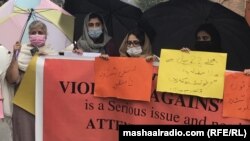Suriya Mehmood, a pseudonym to conceal her identity, 35, lies in an Islamabad hospital bed recuperating from third-degree burns. Her niece claims the injuries were due to an accident, but Mehmood said she purposefully triggered the gas explosion that gave her burns all over her body.
Mehmood, a resident of Gilgit-Baltistan, a remote mountainous region in northwestern Pakistan, was admitted to the burns center at the Pakistan Institute of Medical Sciences (PIMS) Hospital in Islamabad in late May. According to her niece, a sister-in-law left the kitchen stove’s gas on and asked Mehmood to make tea. When she first arrived at the hospital, however, Mehmood made a different statement.
“The patient told us that she committed the act herself,” said Muhammad Rehan, a burn and reconstructive surgeon at PIMS. “She said her husband and in-laws regularly beat her and she had had enough of the situation.”
Married women from low-income backgrounds have the highest rates of self-immolation or suicide by burning in Pakistan. A study by the PIMS burn center reported a total of 75 female self-immolation patients in comparison to just 18 male patients over a two-year period. Sixty-one percent of female patients were married, and a majority of them hailed from rural backgrounds with restricted access to education.
Systemic poverty, domestic violence, low literacy rates, and limited mental health services all increase the risk to self-destructive behaviors among women in Pakistan. A recent study revealed that the phenomenon, which is relatively rare in developed countries, widely occurs across a belt of countries from Turkey, Iran, and Afghanistan to Pakistan and the rest of South Asia.
Marital conflicts and domestic violence are often cited as triggers. A study measuring self-inflicted burns among 154 patients in Jamshoro, a rural district in the southern province of Sindh, indicated that 63 percent of female patients attempted suicide by burning in comparison to 37 percent of male patients. Most female patients reported “family quarrels and marital disharmony” as precipitating factors.
“Female patients largely suffer from domestic problems such as quarrels with husbands or in-laws,” said Ehmar Al-Ibran, head of the burn center at Civil Hospital Karachi, the southern seaport and capital of Sindh. “Sometimes they face domestic violence every day, which eventually takes a toll on them.”
Islamabad-based psychiatrist Abdul Wahab Yousafzai says that in addition to domestic violence, such patients typically deal with a lack of socioeconomic empowerment, steep parental expectations, and peer pressure.
“So many factors are involved, but domestic violence is very prominent, and you can imagine the level of empowerment they have. They have very little say in deciding very personal things, which is extremely distressing,” he said.
Research shows that individuals experiencing domestic violence are especially vulnerable to suicidal ideation and attempts.
“When women get so desperate and traumatized, they think this is the only option,” said Mehnaz Rahman, director of Aurat Foundation, a women’s rights NGO in Karachi. “There have been cases where women jumped into a lake or canal and committed suicide with their children.”
Despite its prevalence, self-immolation is severely underreported in Pakistan due to a colonial-era law that criminalizes suicide. According to the Pakistani Criminal Code, those who attempt suicide can be fined or imprisoned for up to a year.
Pakistan has no national suicide registry, so there is little centralized data on the frequency of self-immolation. The societal stigmatization of mental illness and suicide also hinders reporting and psychiatric treatment for those who need it.
“Patients tend to hide what happened when they come [to the hospital] because they are not willing to talk about it,” said Rehan. “Sometimes because of their families or social pressure, they even end up changing their original statements.”
Social taboos around suicide and polarized family reactions also increase the likelihood of patients not receiving the aftercare required once they leave the hospital. “A patient whose body has been 40 to 60 percent burned has to be taken care of,” said burn surgeon Basit Ali. “They need intensive care, and they need support from their families and friends, as well. Aftercare neglect is one of the main reasons some don't survive.”
Another issue that clouds the evaluation of a woman who may have self-immolated is the potential of homicidal violence. According to Rahman, some cases that are categorized as self-immolations are in truth murder by close relatives.
“Sometimes the victim never gets a chance to give a statement before she dies,” said Rahman. “And other times there is so much pressure on her that she refuses to tell the truth of what happened.”
Based on a survey by the Thomson Reuters Foundation, Pakistan ranks as the sixth most dangerous country in the world for women. In 2020, 2,297 women experienced some form of violence including sexual assault, domestic violence, and acid attacks. The real number, however, is likely much higher because so few cases are reported.
“I have seen cases where husbands, mother in-laws, or other family members have thrown acid on them, set fire to them, or thrown boiling water on them,” said Ali.
Over the years, Pakistan has ratified several domestic violence laws. In 2013, the Sindh provincial assembly passed the Domestic Violence Prevention and Protection Act. The provinces of Balochistan and Punjab followed suit with similar legislation in 2014 and 2016, respectively. The northwestern province of Khyber Pakhtunkhwa passed its long-anticipated domestic violence law earlier this year. The law had been proposed earlier in 2012 but was delayed due to opposition from religious groups.
Despite recent advancements in legislation, ground-level implementation has been scarce. Many women’s rights organizations such as the Aurat Foundation are working tirelessly to raise awareness. According to Rahman, the country’s women protection laws are commendable but lack adequate oversight.
“Police aren’t aware of the laws in place. The judiciary is not aware of them,” she said. “There needs to be a system that creates awareness so that everyone knows about the current laws and how those laws can protect them.”











